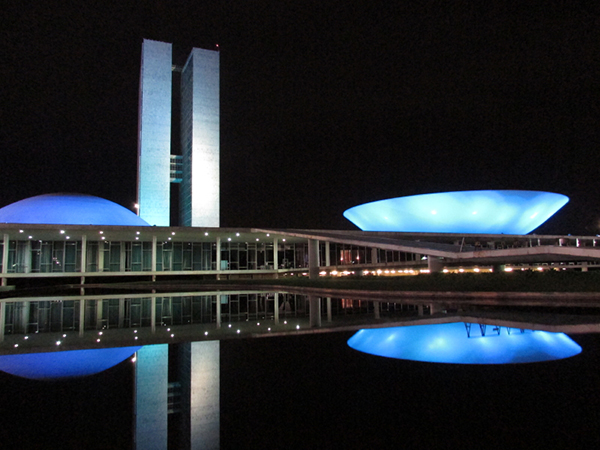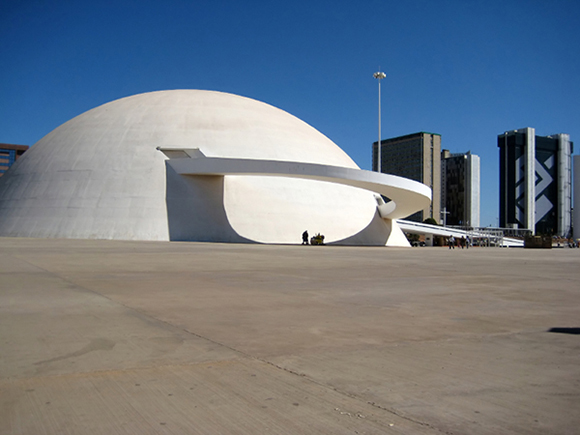This futuristic ensemble is the parliament of Brazil. The right-side up saucer contains the Senate, while the upside down saucer is the seat of the Chamber of Deputies. The two skyscrapers house the offices of bureaucrats, senators and deputies.

If it’s true that ingenuity lies in simplicity, we should prostrate before Brazilian architect Oscar Niemeyer. His parliament building, called the Brazilian National Congress, is simple, elegant and efficient.
It is under these domes that deputies and senators discuss the forthcoming World Cup of Soccer and the Rio Olympic Games.
Obviously it doesn’t make sense for senators and deputies to debate in such hermetic buildings. Actually they don’t; the two domes are symbols more than anything else. The two parliamentary assemblies are partially underground. The dome that opens to the sky symbolizes the deputies’ openness to the people, while the upside down dome symbolizes reflection.
Loyal to its philosophy, the Guide du Routard takes pride in providing the people’s point of view for which “the overturned bowl evokes comfortable senators, while its alter ego symbolizes deputies who are demanding to eat.”
The parliament is in Brasilia, the nation’s capital. To understand Niemeyer’s work, you have to understand Brasilia. It’s an artificial city built in a flash at the end of the 50s. A crazy idea by the president of the Republic at the time who wanted to conquer the virgin land inside the country. Many Brazilians and foreign governments derided the project. Pure megalomania, they said.

Niemeyer, along with twenty architects, engineers and an army of workers, travelled hundreds of kilometres from the beaches of Rio to build Brasilia. It was a life of exile, like in Quebec in the era of the big Bay James projects. No distractions, rudimentary life, little family. Living in the middle of nowhere, the exiled workers cleared the land, organized, and built.
The first materials were transported by helicopter. For architect Oscar Niemeyer, Brasilia was a gift from heaven. “I understood that what I had in front of me was a project that matches my imagination. Is there an architect worthy of this name in the world who would refuse to meet such a challenge?” he said.
Niemeyer was responsible for building most of Brasilia’s first buildings: parliament, administrative buildings, cathedral, museum and many others. The entire world watched as strange shapes rose from the ground in Brasilia.
“Curves allowed me to express my emotions by working with reinforced concrete,” explained Niemeyer who fought against right angles at the time. He added “Architecture must follow the architect’s fantasies.”
Three years after the work began, the president of the republic inaugurated Brasilia. It is said that he liked to contemplate the city under a star-filled sky. It must have been pleasant since almost all of the first buildings were white.
Niemeyer recounts how, in a French movie theatre, spectators applauded upon seeing the heart of Brasilia arise under an airplane that was flying over it. It was the movie The Man from Rio with actor Jean-Paul Belmondo.
Brasilia is a spectacular city, but doesn’t outshine Rio, which is still the most beautiful city in the heart of Brazilians.
References:
- Niemeyer par lui-même, L’architecte de Brasilia parle à Edouard Bailby, Balland biographies, Éditions Balland, Paris, 1993, 224 pages
- Brésil, Le Guide du Routard, Hachette, 2013, 659 pages
- English Wikipedia article on Oscar Niemeyer
- English Wikipedia article on Brasilia
- English Wikipedia article on Three Powers Plaza
Photos: iStockphoto LP